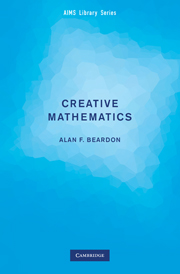25 - Problem J: Discussion and Generalisations
Published online by Cambridge University Press: 16 May 2024
Summary
First, we consider the case n = 4. The four points a1, a2, a3 and a4 form the midpoints of a quadrilateral with vertices v1, v2, v3 and v4 if and only if the vj satisfy the simultaneous vector equations
If there is a solution then a1 + a3 = a2 + a4 or, equivalently, a1 − a2 = a4 − a3, which says (and you should prove this) that the aj are the vertices of a parallelogram. If this is so, then given any b, there is a quadrilateral that is a solution with a vertex at b. We are now in a position to make a conjecture.
• Conjecture: suppose that we are given distinct points a1, … an. If n is odd there is a unique n-gon with the aj as the midpoints of the sides of the n-gon. If n is even, and if a certain linear combination of the aj is zero, then infinitely many solutions exist. If this linear combination is not zero, then there is no solution.
Obviously, we want to know more about the linear combination in the case when n is even. When n = 2 it is a1 − a2 = 0; when n = 4 it is a1 − a2 + a3 − a4 = 0.
• What do you think it is in the general case?
We shall now give a complete solution to the problem. This solution is algebraic, but is based on a geometric idea. It is valid in all dimensions, and it does not require themidpoints aj , or the vertices vj , to be coplanar. Given a1, … , an we construct a map f (x) as follows. Start with x and reflect x through the point a1 to obtain x1 = 2a1 − x. Now reflect x1 through the point a2 to get
Next, reflect x2 through a3 to get x3, where
We continue this process until we have reflected through the point an, and the resulting point is f (x). Thus
- Type
- Chapter
- Information
- Creative MathematicsA Gateway to Research, pp. 103 - 106Publisher: Cambridge University PressPrint publication year: 2009

